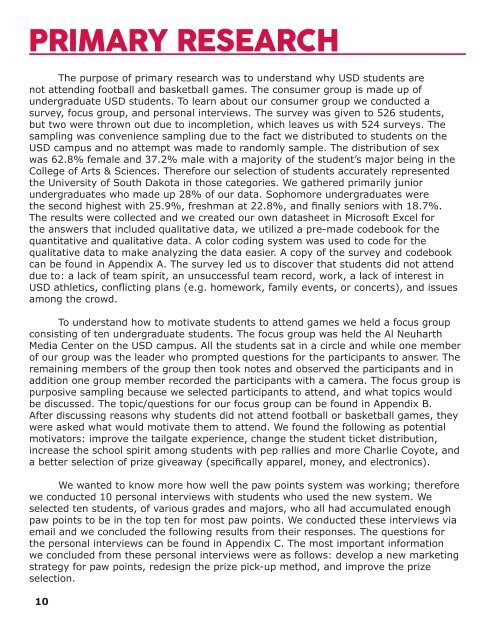CONSULTANTS
You also want an ePaper? Increase the reach of your titles
YUMPU automatically turns print PDFs into web optimized ePapers that Google loves.
PRIMARY RESEARCH<br />
The purpose of primary research was to understand why USD students are<br />
not attending football and basketball games. The consumer group is made up of<br />
undergraduate USD students. To learn about our consumer group we conducted a<br />
survey, focus group, and personal interviews. The survey was given to 526 students,<br />
but two were thrown out due to incompletion, which leaves us with 524 surveys. The<br />
sampling was convenience sampling due to the fact we distributed to students on the<br />
USD campus and no attempt was made to randomly sample. The distribution of sex<br />
was 62.8% female and 37.2% male with a majority of the student’s major being in the<br />
College of Arts & Sciences. Therefore our selection of students accurately represented<br />
the University of South Dakota in those categories. We gathered primarily junior<br />
undergraduates who made up 28% of our data. Sophomore undergraduates were<br />
<br />
The results were collected and we created our own datasheet in Microsoft Excel for<br />
the answers that included qualitative data, we utilized a pre-made codebook for the<br />
quantitative and qualitative data. A color coding system was used to code for the<br />
qualitative data to make analyzing the data easier. A copy of the survey and codebook<br />
can be found in Appendix A. The survey led us to discover that students did not attend<br />
due to: a lack of team spirit, an unsuccessful team record, work, a lack of interest in<br />
<br />
among the crowd.<br />
To understand how to motivate students to attend games we held a focus group<br />
consisting of ten undergraduate students. The focus group was held the Al Neuharth<br />
Media Center on the USD campus. All the students sat in a circle and while one member<br />
of our group was the leader who prompted questions for the participants to answer. The<br />
remaining members of the group then took notes and observed the participants and in<br />
addition one group member recorded the participants with a camera. The focus group is<br />
purposive sampling because we selected participants to attend, and what topics would<br />
be discussed. The topic/questions for our focus group can be found in Appendix B.<br />
After discussing reasons why students did not attend football or basketball games, they<br />
were asked what would motivate them to attend. We found the following as potential<br />
motivators: improve the tailgate experience, change the student ticket distribution,<br />
increase the school spirit among students with pep rallies and more Charlie Coyote, and<br />
<br />
We wanted to know more how well the paw points system was working; therefore<br />
we conducted 10 personal interviews with students who used the new system. We<br />
selected ten students, of various grades and majors, who all had accumulated enough<br />
paw points to be in the top ten for most paw points. We conducted these interviews via<br />
email and we concluded the following results from their responses. The questions for<br />
the personal interviews can be found in Appendix C. The most important information<br />
we concluded from these personal interviews were as follows: develop a new marketing<br />
strategy for paw points, redesign the prize pick-up method, and improve the prize<br />
selection.<br />
10


